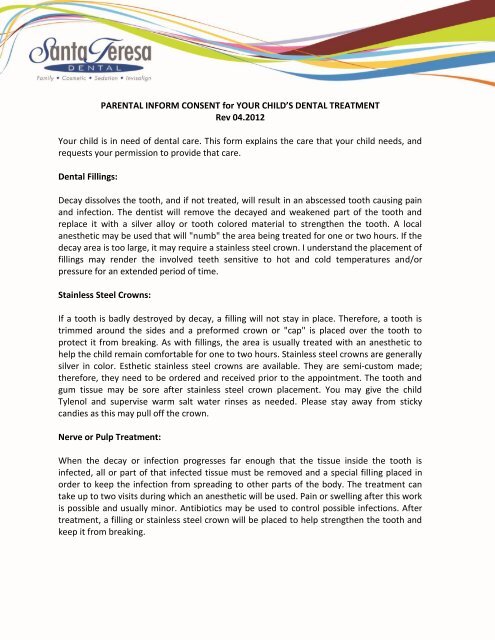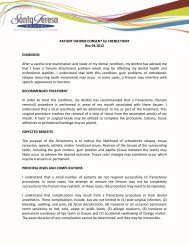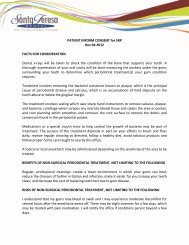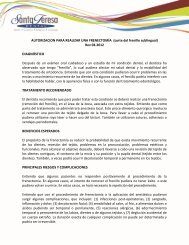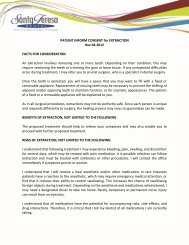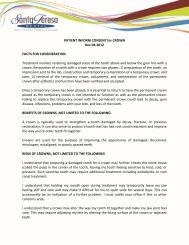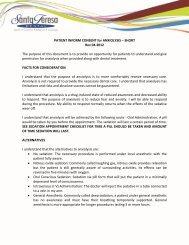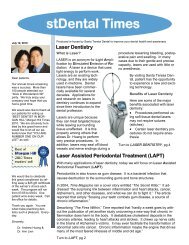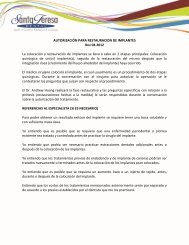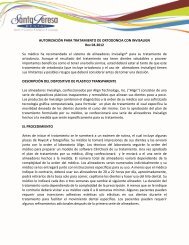Child Treatment - Consent Form
Child Treatment - Consent Form
Child Treatment - Consent Form
You also want an ePaper? Increase the reach of your titles
YUMPU automatically turns print PDFs into web optimized ePapers that Google loves.
PARENTAL INFORM CONSENT for YOUR CHILD’S DENTAL TREATMENT<br />
Rev 04.2012<br />
Your child is in need of dental care. This form explains the care that your child needs, and<br />
requests your permission to provide that care.<br />
Dental Fillings:<br />
Decay dissolves the tooth, and if not treated, will result in an abscessed tooth causing pain<br />
and infection. The dentist will remove the decayed and weakened part of the tooth and<br />
replace it with a silver alloy or tooth colored material to strengthen the tooth. A local<br />
anesthetic may be used that will "numb" the area being treated for one or two hours. If the<br />
decay area is too large, it may require a stainless steel crown. I understand the placement of<br />
fillings may render the involved teeth sensitive to hot and cold temperatures and/or<br />
pressure for an extended period of time.<br />
Stainless Steel Crowns:<br />
If a tooth is badly destroyed by decay, a filling will not stay in place. Therefore, a tooth is<br />
trimmed around the sides and a preformed crown or "cap" is placed over the tooth to<br />
protect it from breaking. As with fillings, the area is usually treated with an anesthetic to<br />
help the child remain comfortable for one to two hours. Stainless steel crowns are generally<br />
silver in color. Esthetic stainless steel crowns are available. They are semi-custom made;<br />
therefore, they need to be ordered and received prior to the appointment. The tooth and<br />
gum tissue may be sore after stainless steel crown placement. You may give the child<br />
Tylenol and supervise warm salt water rinses as needed. Please stay away from sticky<br />
candies as this may pull off the crown.<br />
Nerve or Pulp <strong>Treatment</strong>:<br />
When the decay or infection progresses far enough that the tissue inside the tooth is<br />
infected, all or part of that infected tissue must be removed and a special filling placed in<br />
order to keep the infection from spreading to other parts of the body. The treatment can<br />
take up to two visits during which an anesthetic will be used. Pain or swelling after this work<br />
is possible and usually minor. Antibiotics may be used to control possible infections. After<br />
treatment, a filling or stainless steel crown will be placed to help strengthen the tooth and<br />
keep it from breaking.
Sealants:<br />
Back teeth have grooves and pits in which decay usually starts. The dentist or hygienist will<br />
"seal" the grooves with a plastic coating to help prevent the decay from starting. No<br />
anesthetic is needed.<br />
Extraction or Removal of the Tooth:<br />
If the infection has spread too far to rebuild the tooth, it is often best to remove the tooth<br />
to prevent infection from spreading. After "numbing" the area with anesthetics, the tooth is<br />
removed and the area packed with gauze to control bleeding. Care should be taken not to<br />
rinse for a couple of days or bleeding may begin again. Biting on gauze or towels will usually<br />
stop the bleeding. Pain or swelling after this work is possible and usually minor.<br />
Nitrous Oxide and/or Premedication:<br />
If a child is particularly nervous about dental treatment, the dentist may use "laughing gas"<br />
(nitrous oxide) or some other medication to help relax the child so the work can be done<br />
properly. The medications may cause the child to be drowsy after the appointment.<br />
<strong>Treatment</strong> plan change and/or addition:<br />
During the incidences when a general anesthesiologist was utilized, parents authorize the<br />
dental practice and the dentists to use their professional judgment in making decisions<br />
regarding your child’s treatment as the circumstances warrant in fulfilling the healthrelated,<br />
function and aesthetic objectives set out in your child’s treatment plan and clinical<br />
records.<br />
I understand that unforeseen circumstances may arise that may necessitate a decision<br />
being made on my child’s behalf. I give the dental practice and the dentist’s full<br />
authorization to make treatment plan changes and/or addition.
In cases the child becomes uncooperative:<br />
I understand that should the patient become uncooperative during dental procedures with<br />
movement of head, arms and/or legs, dental treatment cannot be safely provided. During<br />
such disruptive behavior, it may be necessary for the assistant(s) to hold the patient’s<br />
hands, stability the head and/or control leg movements. Procedure may not be<br />
continued or completed if safety and cooperative cannot be maintained. Your child may<br />
need to be referred to a specialist which is your responsibility.<br />
Local anesthesia risk:<br />
I understand that the administration of local anesthesia may cause an untoward reaction of<br />
side effects, which may include, but are not limited to temporary bruising, hematoma,<br />
cardiac stimulation, muscle soreness or rarely, permanent numbness.<br />
No guarantee or assurance has been given to me by anyone that the proposed treatment or<br />
surgery will cure or improve the child’s condition(s).<br />
I have been given the opportunity to ask questions, and I consent to the above treatment<br />
plan after having been advised of the alternate plans of treatment available, the known<br />
material risks of the treatment to be used and consequences if this treatment were<br />
withheld.


